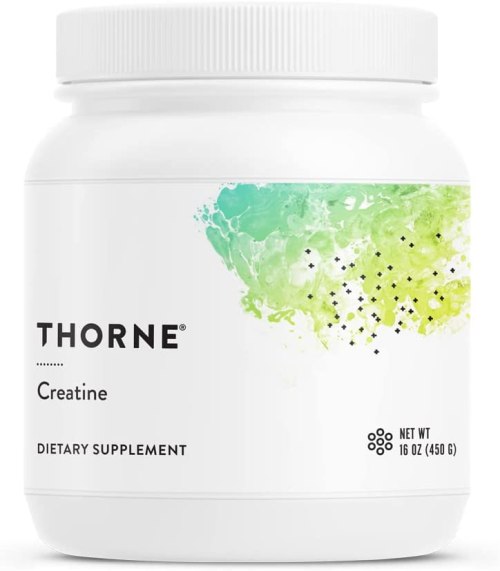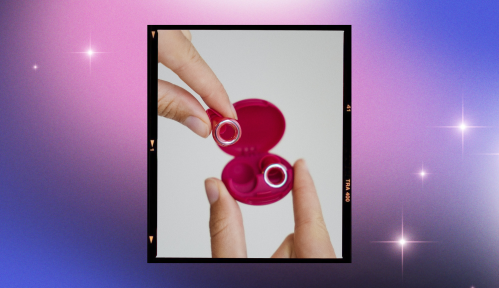Our editors independently select these products. Making a purchase through our links may earn Well+Good a commission
What Is Creatine and Why Is Everyone at the Gym Taking This Buzzy Supplement?
Creatine has been making rounds on GymTok as a muscle-building super supplement. Here, a registered dietitian explains how it works.

If you’re a gym rat like me, your cupboard is probably jam-packed with a multitude of different-sized tubs. Pre-workouts and protein powders have officially taken over my teeny tiny apartment pantry. A certain supplement making rounds on GymTok has me considering a visit to my local sports supplement store recently, despite the limited amount of space left on my shelves.
I’d heard of creatine supplements before joining TikTok, but after joining the app, I found myself surrounded by influencers touting its muscle-building benefits. There’s even a viral audio on TikTok that joke about how taking creatine can help you build the booty of your dreams.
What is creatine, though? And why do weightlifters love it so much?
What is creatine?
Creatine (Cr) is a nitrogenous amino acid that’s found naturally within the human body, predominantly within the muscles and brain. Creatine, when combined with phosphate, delivers a constant flow of energy to muscles, enhancing muscular endurance and preventing muscular fatigue. Most people get about half of their creatine stores from eating eggs, red meats, poultry, and fish, while the other half is created in the kidneys and liver. On an average day, a meat-eating adult human gets about 1-2 grams of creatine from their diet without supplementation.
There are several different types of creatine supplements on the market, with the most commonly used (and recommended) being creatine monohydrate. Sold in powder and pill form, this is the most widely reviewed and researched supplement in the creatine family. Chances are, this is the supplement that your favorite GymTok influencer is taking when they say they’re taking creatine.
The Potential Benefits of Taking Creatine
Creatine provides a burst of energy to your muscles, allowing you to work out harder and longer—and recover faster, too. It’s most effective for improving performance in high-intensity, short-duration sports like powerlifting.
Registered dietitian and The Nutrition Lady founder Russender Powell says that creatine is beloved amongst performance athletes for its energy-boosting effects.
“Simply stated, creatine is an energy enhancer,” notes Powell. “Your muscle increases its capacity to do more hard work to lay the foundation for muscle mass. This ability to do higher-intensity exercise can stimulate muscles to grow bigger and stronger.”
In 2020, the International Society of Sports Nutrition (ISSN) compiled all peer-reviewed literature and studies surrounding creatine use, and stands that creatine is the “most effective ergogenic nutritional supplement currently available to athletes with the intent of increasing high-intensity exercise capacity and lean body mass during training.”
“It helps your body recycle the energy better,” says Powell. “These athletes, or someone who just works out a lot, are able to produce more energy quicker with it. If they’re lifting 500 pounds, it’s not going to exhaust them as much if they have creatine in the background.”
Is creatine safe to consume?
Creatine monohydrate might just be the most-studied sports supplement on the market; so much so, in fact, that both the International Olympic Committee and National Collegiate Athletic Association permit the use of creatine supplementation by participants. The International Society of Sports Nutrition stands that there is no scientific evidence that short or long term use of creatine causes any harmful effects on healthy adults (of up to 30 grams per day, for five years).
While a multitude of studies surrounding creatine usage support that creatine is perfectly safe for healthy adults to consume, folks who struggle with liver and kidney function or have diabetes should steer clear from it.
“It’s relatively safe,” says Powell, “but if you have some underlying kidney or liver issues, it may cause harm since nitrogen-containing components can increase demand on the two. Someone who has liver cirrhosis, or chronic kidney disease, diabetes, or a fatty liver, their liver is already kind of challenged. You want to really watch those types of supplements because they can just be a little too demanding on our system.”
Something to note, however, is that like all other nutritional supplements on the market, creatine supplements are not regulated by the Food and Drug Administration. When you consume supplements, there’s always an off chance that the quality, quantity, and ingredients in the product are not what’s stated on the label. Without federal regulation, you run the risk of ingesting a product that contains filler ingredients that could adversely affect you.
Powell says that if you’re going to try any sports supplement, make sure you’re purchasing from a brand that is certified by a third party company like ConsumerLab or the United States Pharmacopeial Convention. These companies run independent tests to verify the supplement’s purity and efficacy.
“They’re almost like outside auditors,” says Powell. “They will test for horrible, harmful substances in the product. Also the conditions in which it’s produced; is it made in a clean environment? Is this product going to be effective? Basically everything that the FDA should do for supplements, these parties do, and they will give you certificates to show that this has been tested for purity and quality standards.”
Below are two creatine supplements that have been tested by third party companies and are NSF (National Sanitation Foundation) certified for sports nutrition.

Klean Athlete Klean Creatine — $29.00

Thorne Research Creatine Monohydrate — $35.00
Things You Need To Know Before Taking Creatine
1. You don’t need it to build muscle
While creatine could help some people reach performance goals, it’s really not necessary for building muscle, says Powell. The added gym time is what makes creatine an effective supplement: when your muscles are recovering faster and have more energy, you’re able to power through more workouts.
So if you’re looking to gain some muscle, start by adding in more resistance training to your workout and aim to get in at least 1 to 2 grams of protein per kilogram of bodyweight everyday.
“Anything that’s going to put work out the muscle, so resistance training, weightlifting, using your own body weight can help,” says Powell. “The best muscle builder is resistance exercise that fatigues your muscles to lay the foundation to build muscle mass. Hard work equals muscle mass. If you’re constantly using a muscle group, you’re gonna increase it, especially if you’re doing it consistently.”
2. There’s a laundry list of potential side effects, including liver and kidney damage
Bloating, dehydration, diarrhea, high blood pressure, weight gain, kidney damage, and liver damage are just a few of the possible side effects of taking creatine. While these vary from person to person, and depend on the amount consumed, the potential risk might not be worth the reward for you.
As with any supplement, always consult with your doctor before trying it.
3. Creatine isn’t a shortcut, and it’s not a magic pill
As with any other supplement, you won’t magically become more fit from adding it into your daily supplement stack. You’ll need anywhere from 7 to 28 days to see a change in energy, and Powell warns that using supplements as a shortcut will only lead to disappointment.
“If you take creatine and don’t do anything, it’s not going to do anything for you,” says Powell. “It’s a performance enhancer meant for someone to perform; if you sit on the couch and think you’re going to bulk up, it’s not going to happen. There are no shortcuts!”
Sign up for the Well+Good SHOP Newsletter
Get exclusive deals on wellness, beauty, fitness, and food products that have been hand-picked by our editors.
Got it, you've been added to our email list.









